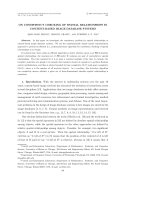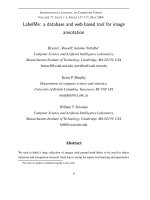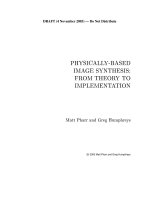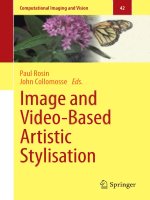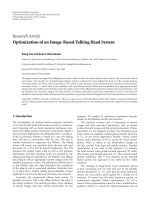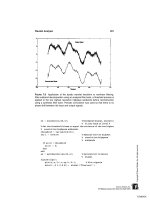shum, chan, kang - image based rendering
Bạn đang xem bản rút gọn của tài liệu. Xem và tải ngay bản đầy đủ của tài liệu tại đây (24.39 MB, 425 trang )
Image-Based Rendering
Image-Based Rendering
Heung-Yeung Shum
Microsoft Research Asia
Shing-Chow Chan
University of Hong Kong
Sing Bing Kang
Microsoft Research USA
Springer
Heung-Yeung Shum
Microsoft Research Asia
Shing-Chow Chan
University of Hong Kong
Sing Bing Kang
Microsoft Research USA
Library of Congress Control Number: 2006924121
ISBN-10: 0-387-21113-6 e-ISBN-10: 0-387-32668-5
ISBN-13:
978-0387-21113-8 e-ISBN-13: 978-0387-32668-9
© 2007 by Springer Science-hBusiness Media, LLC
All rights reserved. This work may not be translated or copied in whole or in part without the written
permission of the publisher (Springer Science -i- Business Media, LLC, 233 Spring Street, New York,
NY 10013, USA), except for brief excerpts in connection with reviews or scholarly analysis. Use in
connection with any form of information storage and retrieval, electronic adaptation, computer
software, or by similar or dissimilar methodology now known or hereafter developed is forbidden.
The use in this publication of trade names, trademarks, service marks and similar terms, even if they
are not identified as such, is not to be taken as an expression of opinion as to whether or not they are
subject to proprietary rights.
Printed in the United States of America
98765432 1
springer.com
Foreword
Ten years ago there were two worlds of research that rarely crossed. My world, the
world of computer graphics, tried to solve a well-defined problem. Given the geo-
metrical and material description of a virtual scene, a definition of the light sources
in that scene, and a virtual camera, create an image that looks as close as possible to
one that a real camera in a real version of the described scene would look like. In the
other research world, that of computer vision, researchers were struggling with the
opposite question. Given one or more real images of a real scene, get the computer
to describe the geometrical, material, and lighting properties in that real scene.
The computer graphics problem was having great success, to a point. Surprising
to many of us, the real problem derived from a realization that the geometric com-
plexity of the real world overwhelmed our abilities to create it in current geometric
modelers. Consider a child's fuzzy stuffed lion. To create an accurate image of such
a lion could require the daunting task of describing every strand of hair and how it
reflects and transmits light. This is about when we went to knock on the doors of
our computer vision colleagues. We hoped, a bit prematurely, that perhaps we could
just point cameras at the fuzzy lion and a computer vision algorithm could spit out
the full geometric description of the lion. The state-of-the-art was (and still is) that
computer vision algorithms could give us an approximate model of the scene but not
the kind of detail we needed. In some ways we were lucky, for if they had given
us the full model in all its detail, the computer graphics rendering algorithms most
likely could not deal with such complex models.
It was this point that the ideas underlying image based rendering were born. The
idea is that by using the partial success of computer vision algorithms PLUS keeping
the original pixels contained in the input images, one could then leverage the partial
success of computer graphics. I feel quite honored to have been a part of making
some of the first realistic synthetic images of a child's stuffed lion in just this way.
The results that have grown from this initial idea have been quite astounding.
The book you are about to read introduces the reader to the rich collaboration
that has taken place over the past decade at the intersection of computer graphics
and computer vision. The authors have lived in this exciting research world and have
produced many of
the
seminal papers in the field. The book provides both a historical
perspective and the technical background for the reader to become familiar with the
major ideas and advances in the field. This can, in turn, provide the basis for the
many new discoveries awaiting anyone willing to jump into the field. The results are
already having a major impact on the computer game and film industry. Similar ideas
are also finding their way into consumer products for digital photography and video.
Hopefully the reader will find new ways to apply these ideas in yet undiscovered
ways.
Michael Cohen
March 2006
Seattle, WA
Preface
When image-based rendering (IBR) first appeared in the graphics scene about ten
years ago, it was greeted with a lot of
enthusiasm.
It was new and fresh then and it had
(and still has) the potential for generating photorealistic images. Unlike traditional
3D computer graphics in which 3D geometry of the scene is known, IBR techniques
render novel views directly from input images. It was this aspect of IBR that attracted
much attention. Pioneering works in this area include Chen and Williams' view in-
terpolation, Chen's QTVR, McMillan and Bishop's plenoptic modeling, Levoy and
Hanrahan's light field, and Gortler et al.'s Lumigraph.
IBR is unique in graphics in that it drew significant interest not only from re-
searchers in graphics, but researchers in computer vision as well as image and signal
processing. A lot of progress has been made in this field, in terms of improving the
quality of rendering and increasing its generality. For example, more representations
have been proposed in order to handle more scenarios such as increased virtual mo-
tion, complicated non-rigid effects (highly non-Lambertian surfaces), and dynamic
scenes. Much more is known now about the fundamental issue of sampling for IBR,
which is important for the process of image acquisition. There is also a significant
amount of work on compression techniques specifically geared for IBR. These tech-
niques are critical for the practical use of IBR in conventional PCs. Interestingly,
despite the large body of work accumulated over the years, there was no single book
that is devoted exclusively to IBR.
This was the primary motivation for this book. Much of the material in this book
is the result of years of research by the authors at Microsoft Research (in Redmond
and Beijing) and through collaboration between Microsoft Research and The Uni-
versity of Hong Kong. The book is intended for researchers and practitioners in the
fields of vision, graphics, and image processing.
Microsoft Research Asia Heung-Yeung Shum
The University of Hong Kong Shing-Chow Chan
Microsoft Research Sing Bing Kang
February 2006
Acknowledgments
There are many people we would like to thank for making this book possible. The
figures in this book were used with permission from the following people: Aseem
Agarwala, Simon Baker, German Cheung, Michael Cohen, Xavier Decoret, Olivier
Faugeras, Doron Feldman, Bastian Goldliicke, Adrian Hilton, Stefan Jeschke, Takeo
Kanade, Marc Levoy, Stephane Laveau, Maxime Lhuillier, Tim Macmillan, Mar-
cus Magnor, Wojciech Matusik, Manuel Menezes de Oliveira Neto, Shmuel Peleg,
Marc Pollefeys, Alex Rav-Acha, Steve Seitz, Richard Szeliski, Dayton Taylor, Chris-
tian Theobalt, Matthew Uyttendaele, Sundar Vedula, Daphna Weinshall, Bennett
Wilburn, Colin Zheng, and Assaf Zomet. Yin Li and Xin Tong wrote the first draft
for Chapter 4. Sundar Vedula provided useful comments for Chapters 3 and 4.
Heung-Yeung Shum would like to thank his co-authors: Rick Szeliski, Li-Wei
He,
Zhouchen Lin, Jin-Xiang Chai, Xin Tong, Lifeng Wang, Tao Feng, Yin Li,
Qifa Ke, King To Ng, Jian Sun, Chi-Keung Tang, Minsheng Wu, Zhunping Zhang,
Baining Guo, Steve Lin, Jin Li, Yaqin Zhang, Honghui Sun, Zhengyou Zhang and
Shuntaro Yamazaki. Raj Reddy, Katsushi Ikeuchi, Rick Szeliski, and Michael Cohen
have been instrumental in introducing H Y. Shum to the area of image-based mod-
eling and rendering. He would like to express his appreciation to Eric Chen and Ken
Turkowski for introducing him to QuickTime VR at Apple. He would also like to
thank Pat Hanrahan for his helpful discussion on the minimum sampling of Concen-
tric Mosaics.
Shing-Chow Chan would specifically acknowledge the following people and or-
ganization: King To Ng (for his help in preparing the manuscript); Vannie Wing Yi
Lau, Qing Wu, and Zhi Feng Gan (for their help in preparing some of the figures);
James Lap Chung Koo (for his excellent technical support and the development of the
plenoptic video systems); Olivia Pui Kuen Chan (for help in capturing the plenoptic
videos); the University of Hong Kong, the Hong Kong Research Grant Council, and
Microsoft Research (for their support).
Sing Bing Kang would like to thank his past and present collaborators: Katsushi
Ikeuchi, Rick Szeliski, Larry Zitnick, Matt Uyttendaele, Simon Winder, Yingqing
Xu, Steve Lin, Lifeng Wang, Xin Tong, Zhouchen Lin, Antonio Criminisi, Yasuyuki
Matsushita, Yin Li, Steve Seitz, Jim Rehg, Tat-Jen Cham, Andrew Johnson, Huong
Quynh Dinh, Pavan Desikan, Yanghai Tsin, Sam
Hasinoff,
Noah Snavely, Eric Ben-
nett, Ce Liu, Rahul Swaminathan, Vaibhav Vaish, Yuanzhen Li, Songhua Xu, Yuanjie
Zheng, Hiroshi Kawasaki, Alejandro Troccoli, Michael Cohen, and Gerard Medioni.
He is especially grateful to Katsushi Ikeuchi for having the patience to train him to be
an effective researcher while he was a graduate student at CMU. He also appreciates
Rick Szeliski's invaluable guidance over the past ten years.
Finally, we would like to express our gratitude to Valerie Schofield, Melissa
Fearon, and Wayne Wheeler at Springer for their assistance in making this book
possible. They have been particularly supportive and patient.
Dedication
To our families, with love.
Contents
Foreword v
Preface vii
Acknowledgments ix
1 Introduction 1
1.1 Representations and Rendering 2
1.2 Sampling 3
1.3 Compression 3
1.4 Organization of book 4
Part I: Representations and Rendering Techniques 7
2 Static Scene Representations 9
2.1 Rendering with no geometry 9
2.1.1 Plenoptie modeling 9
2.1.2 Light field and Lumigraph 10
2.1.3 Concentric Mosaics 13
2.1.4 Multiperspective images and manifold mosaics 17
2.1.5 Image mosaicing 18
2.1.6 Handling dynamic elements in panoramas 20
2.2 Rendering with implicit geometry 23
2.2.1 View interpolation 24
2.2.2 View morphing 24
2.2.3 Joint view triangulation 26
2.2.4 Transfer methods 28
2.3 Representations with explicit geometry 31
2.3.1 Billboards 31
2.3.2 3D warping 32
2.3.3 Layered Depth Images 33
Contents
2.3.4 View-dependent texture mapping 34
2.4 Handling non-rigid effects 35
2.4.1 Analysis using the EPI 36
2.4.2 Local diffuse and non-diffuse geometries 36
2.4.3 Implementation 38
2.4.4 Results with two real scenes 39
2.4.5 Issues with LRL 41
2.5 Which representation to choose? 41
2.6 Challenges 42
Rendering Dynamic Scenes 45
3.1 Video-based rendering 47
3.2 Stereo with dynamic scenes 48
3.3 Virtualized Reality'i'^'' 49
3.3.1 Video acquisition system 49
3.3.2 Camera calibration and model extraction 49
3.3.3 Spatial-temporal view interpolation 50
3.4 Image-based visual hulls 54
3.4.1 Computing the IBVH 55
3.4.2 Texture-mapping the IBVH 55
3.4.3 System implementation 55
3.5 Stanford Light Field Camera 56
3.5.1 Depth map extraction 57
3.5.2 Interactive rendering 59
3.6 Model-based rendering 59
3.6.1 Free viewpoint video of human actors 59
3.6.2 Markerless human motion transfer 61
3.6.3 Model-based multiple view reconstruction of people 62
3.7 Layer-based rendering 63
3.7.1 Hardware system 64
3.7.2 Image-based representation 64
3.7.3 Stereo algorithm 65
3.7.4 Rendering 65
3.8 Comparisons of systems 67
3.8.1 Camera setup 68
3.8.2 Scene representation 69
3.8.3 Compression and rendering 69
3.9 Challenges 70
Rendering Techniques 71
4.1 Geometry-rendering matrix 72
4.1.1 Types of rendering 73
4.1.2 Organization of chapter 73
4.2 Rendering with no geometry 74
4.2.1 Ray space interpolation 74
Contents xv
4.2.2 Other forms of interpolation 75
4.2.3 Hardware rendering 76
4.3 Point-based rendering 77
4.3.1 Forward mapping 77
4.3.2 Backward mapping 81
4.3.3 Hybrid methods 81
4.3.4 Hardware acceleration 82
4.4 Monolithic rendering 84
4.4.1 Using implicit geometry model 84
4.4.2 Using explicit geometry model 85
4.5 Layer-based rendering 88
4.6 Software and hardware issues 89
Part II: Sampling 91
5 Plenoptic Sampling 93
5.1 Introduction 93
5.2 Spectral analysis of light field 95
5.2.1 Light field representation 95
5.2.2 A framework for light field reconstruction 96
5.2.3 Spectral support of light fields 96
5.2.4 Analysis of bounds in spectral support 98
5.2.5 A reconstruction filter using a constant depth 101
5.2.6 Minimum sampling rate for light field rendering 103
5.3 Minimum sampling in joint image-geometry space 105
5.3.1 Minimum sampling with accurate depth 106
5.3.2 Minimum sampling with depth uncertainty 107
5.4 Experiments 108
5.5 Conclusion and Discussion 110
6 Geometric Analysis of Light Field Rendering 115
6.1 Problem formulation 115
6.1.1 Assumptions 115
6.1.2 Anti-aliasing condition 117
6.2 Minimum sampling rate of Concentric Mosaics 123
6.2.1 Review of Concentric Mosaics 123
6.2.2 Minimum sampling condition 125
6.2.3 Lower bound analysis 126
6.2.4 Optimal constant-depth R 128
6.2.5 Validity of bound 128
6.3 Minimum sampling rate of light field 129
6.3.1 Maximum camera spacing 129
6.3.2 Optimal constant depth 133
6.3.3 Interpretation of optimal constant depth 133
6.3.4 Prefiltering the light field 134
xvi Contents
6.3.5 Disparity-based analysis 135
6.3.6 Experiments 135
6.4 Dealing with occlusion 136
7 Optical Analysis of Light Field Rendering 141
7.1 Introduction 141
7.2 Conventional thin lens optical system 142
7.2.1 Ideal thin lens model 142
7.2.2 Depth of field and hyperfocal distance 143
7.3 Light field rendering: An optical analysis 144
7.3.1 Overview of light field rendering 144
7.3.2 Imaging law of light field rendering with constant depth 145
7.3.3 Depth of field 147
7.3.4 Rendering camera on ST plane 148
7.4 Minimum sampling of light field 150
7.4.1 Optimal constant depth 150
7.4.2 Multiple depth layers segmentation 151
7.5 Summary 152
8 Optimizing Rendering Performance using Sampling Analysis 155
8.1 Introduction 155
8.2 Related work 156
8.2.1 Image-based representation 156
8.2.2 Minimum sampling curves for different output resolutions . . 158
8.2.3 Hierarchical image-based representations 158
8.2.4 Image warping 158
8.3 Layered Lumigraph 159
8.3.1 System overview 159
8.3.2 Layered Lumigraph generation and optimization 160
8.3.3 LOD construction for layered Lumigraphs 162
8.4 Layered Lumigraph rendering 162
8.4.1 LOD control in joint image-geometry space 163
8.4.2 Rendering output images 165
8.4.3 Performance of layered Lumigraph rendering 165
8.5 Experimental Results 166
8.6 Summary 168
Part III: Compression 171
9 Introduction to Compression 173
9.1 Waveform coding 173
9.2 Basic concept and terminology 177
9.2.1 Compression ratio 177
9.2.2 Distortion measures 177
9.2.3 Signal delay and implementation complexity 178
Contents xvii
9.2.4 Scalability and error resilience 179
9.2.5 Redundancy and random access 180
9.3 Quantization techniques 180
9.3.1 Scalar quantization 181
9.3.2 Vector quantization (VQ) 183
9.3.3 Image vector quantization 184
10 Image Compression Techniques 187
10.1 Image format 187
10.2 Transform coding of images 188
10.3 JPEG standard 193
10.3.1 Lossless mode 194
10.3.2 Sequential DCT-based coding 194
10.4 The JPEG-2000 standard 197
10.4.1 JPEG-2000 compression engine 198
10.4.2 Bit-stream organization 201
10.4.3 Progression 202
10.4.4 Performance 202
10.5 Appendix: VQ structures 203
10.5.1 Multistage VQ 203
10.5.2 Tree structure VQ (TSVQ) 204
10.5.3 Lattice VQ 205
11 Video Compression Techniques 207
11.1 Video formats 207
11.1.1 Analog videos 207
11.1.2 Digital videos 208
11.1.3 ITU-T BT60I (formerly CCIR601) 209
11.2 Motion compensation/prediction 211
11.2.1 Size and precision of search window 213
11.2.2 Block size 213
11.3 Motion compensated hybrid DCT/DPCM coding 214
11.3.1 Coding of/-frames 214
11.3.2 Coding of P-frames 215
11.3.3 Rate control 216
11.4 Video coding standards 217
11.4.1 H.261 218
11.4.2 H.263 221
11.4.3 MPEG-1 video coding standard 223
11.4.4 MPEG-2 video coding standard 228
11.4.5 MPEG-4 standard 229
xviii Contents
12 Compression of Static Image-based Representations 237
12.
i The problem of IBR compression 237
12.1.1 IBR requirements 237
12.1.2 Different compression approaches 238
12.2 Compression of Concentric Mosaics (CMs) 240
12.2.1 Random access problem 240
12.2.2 Pointers structure 241
12.2.3 Predicting mosaic images using DCP 242
12.2.4 Compression results 246
12.2.5 Other approaches 248
12.3 Compression of light field 249
12.3.1 Conventional techniques 249
12.3.2 Object-based light field compression 252
12.3.3 Sampling and reconstruction of light fields 253
12.3.4 Tracking of IBR objects 255
12.3.5 Rendering and matting of IBR objects 257
12.3.6 Experimental results 260
13 Compression of Dynamic Image-based Representations 265
13.1 The problem of dynamic IBR compression 265
13.2 Compression of panoramic videos 266
13.2.1 Construction of panoramic videos 267
13.2.2 Compression and rendering of panoramic videos 270
13.2.3 Transmission of panoramic videos 276
13.3 Dynamic light fields and plenoptic videos 276
13.3.1 Introduction 276
13.3.2 The plenopfic video 277
13.3.3 Compression of plenoptic videos 280
13.3.4 Rendering of plenoptic videos 285
13.3.5 Other approaches 287
13.4 Object-based compression of plenoptic videos 290
13.4.1 System overview 291
13.4.2 Texture coding 292
13.4.3 Shape coding 294
13.4.4 Depth coding 294
13.4.5 Compression results and performance 295
13.5 Future directions and challenges 299
Part IV: Systems and Applications 303
14 Rendering by Manifold Hopping 305
14.1 Preliminaries 306
14.1.1 Warping manifold mosaics 306
14.1.2 Hopping classification and issues 308
14.2 The signed Hough ray space 309
Contents xix
14.3 Analysis of lateral hopping 312
14.3.1 Local warping 312
14.3.2 Hopping interval 313
14.4 Analysis of looming hopping using extended signed Hough space 314
14.5 Outside looking in 315
14.5.1 Hopping between perspective images 317
14.5.2 Hopping between parallel projection mosaics 317
14.6 Experiments 320
14.6.1 Synthetic environments 320
14.6.2 Real environments 320
14.6.3 Outside looking in 321
14.7 Discussion 321
14.8 Concluding remarks 323
15 Large Environment Rendering using Plenoptic Primitives 329
15.1 Customized visual experience 330
15.2 Organization of chapter 330
15.3 Plenoptic primitives (PPs) 330
15.3.1 Panorama and panoramic video 331
15.3.2 Lumigraph/Light Field representations 331
15.3.3 Concentric Mosaics 331
15.4 Constructing and rendering environments 332
15.5 The authoring process 332
15.6 User interface 334
15.7 Rendering issues 335
15.7.1 Rendering PVs 335
15.7.2 Rendering CMs 335
15.7.3 Ensuring smooth transitions 335
15.8 Experimental results 337
15.8.1 Synthetic environment 338
15.8.2 Real environment 340
15.9 Discussion 343
15.10Concluding remarks 345
16 Pop-Up Light Field: An Interactive Image-Based Modeling and
Rendering System 347
16.1 Motivation and approach 347
16.2 Outline of chapter 348
16.3 Related work 348
16.4 Pop-up light field representation 349
16.4.1 Coherent layers 350
16.4.2 Coherence matting 352
16.4.3 Rendering with coherent matting 354
16.5 Pop-up light field construction 355
16.5.1 UI operators 356
XX
Contents
16.5.2 UI design 356
16.5.3 Layer pop-up 358
16.5.4 Constructing background 360
16.6 Real-time rendering of pop-up ligiit field 361
16.6.1 Data structure 361
16.6.2 Layered rendering algorithm 362
16.6.3 Hardware implementation 363
16.7 Experimental results 364
16.8 Discussion 367
16.9 Concluding remarks 368
17 Feature-Based Light Field Morphing 369
17.1 The morphing problem 369
17.2 Overview 372
17.3 Features and visibility 374
17.3.1 Feature specification 374
17.3.2 Global visibility map 376
17.4 Warping 376
17.4.1 Basic ray-space warping 377
17.4.2 Light field warping 377
17.4.3 Warping for animation 380
17.5 Results 381
17.5.1 3D morphs and animations 381
17.5.2 Key-frame morphing 382
17.5.3 Plenoptic texture transfer 383
17.6 Discussion 383
17.7 Concluding remarks 383
References 385
Index 403
Introduction
One of the primary goals in computer graphics is photorealistic rendering. Much
progress has been made over the years in graphics in a bid to attain this goal, with
significant advancements in 3D representations and model acquisition, measurement
and modeling of object surface properties such as the bidirectional reflectance dis-
tribution function (BRDF) and surface subscattering, illumination modeling, nat-
ural objects such as plants, and natural phenomena such as water, fog, smoke,
snow, and fire. More sophisticated graphics hardware that permit very fast render-
ing, programmable vertex and pixel shading, larger caches and memory footprints,
and floating-point pixel formats also help in the cause. In other words, a variety of
well-established approaches and systems are available for rendering models. See the
surveys on physically-based rendering [232J, global illumination methods [691, and
photon mapping (an extension of ray tracing)
[130].
Despite all the advancements in the more classical areas of computer graphics,
it is still hard to compete with images of real scenes. The rendering quality of envi-
ronments in animated movies such as Shrek 2 and even games such as Ghost Recon
for Xbox 360^*^ is excellent, but there are hints that these environments are syn-
thetic. Websites such as showcase highly photorealistic
images that were generated through raytracing, which is computationally expensive.
The special effects in high-budget movies blend seamlessly in real environments, but
they typically involved many man-hours to create and refine. The observation that
full photorealism is really hard to achieve with conventional 3D and model-based
graphics has led researchers to take a "short-cut" by working directly with real im-
ages.
This approach is called image-based modeling and rendering. Some of the
special effects used in the movie industry were created using image-based rendering
techniques described in this book.
Image-based modeling and rendering techniques have received a lot of attention
as a powerful alternative to traditional geometry-based techniques for image syn-
thesis.
These techniques use images rather than geometry as the main primitives
for rendering novel views. Previous surveys related to image-based rendering (IBR)
have suggested characterizing a technique based on how image-centric or geometry-
Image-Based Rendering
^ Less geometry More geometry
Rendering with Rendering with Rendering with
no geometry implicit geometry explicit geometry
iMitiitiiiiiiniiiiiiiiiiiiiEiiiiiiiiiiiiiiiiiiiniiMiii 8
Light fiekl I^uriiigraph LDIs Texlurc-riiappctl imidels
Conccriliiu mosaics Transfer metliods 3D warping
Mosaicing View morphing View-dependent geometry
View interpolation View-dependent texture
Fig. 1.1. IBR continuum. It shows the main categories used in this book, with representative
members shown. Note that the Lumigraph [911 is a bit of an anomaly in this continuum, since
it uses explicit geometry and a relatively dense set of source images.
centric it is. This has resulted in the image-geometry continuum (or IBR continuum)
of image-based representations [155, 134].
1.1 Representations and Rendering
For didactic purposes, we classify the various rendering techniques (and their as-
sociated representations) into three categories, namely rendering with no geometry,
rendering with implicit geometry, and rendering with explicit geometry. These cate-
gories, depicted in Figure 1.1, should actually be viewed as a continuum rather than
absolute discrete ones, since there are techniques that defy strict categorization.
At one end of the IBR continuum, traditional texture mapping relies on very ac-
curate geometric models but only a few images. In an image-based rendering system
with depth maps (such as 3D warping
[189],
and layered-depth images (LDI)
[264],
and LDI tree [39]), the model consists of a set of images of a scene and their as-
sociated depth maps. The surface light field [323] is another geometry-based IBR
representation which uses images and Cyberware scanned range data. When depth
is available for every point in an image, the image can be rendered from any nearby
point of view by projecting the pixels of the image to their proper 3D locations and
re-projecting them onto a new picture. For many synthetic environments or objects,
depth is available. However, obtaining depth information from real images is hard
even with state-of-art vision algorithms.
Some image-based rendering systems do not require explicit geometric models.
Rather, they require feature correspondence between images. For example, view in-
terpolation techniques [40] generate novel views by interpolating optical flow be-
tween corresponding points. On the other hand, view morphing [260] results in-
between camera matrices along the line of two original camera centers, based on
point correspondences. Computer vision techniques are usually used to generate such
correspondences.
Introduction 3
At the other extreme, light field rendering uses many images but does not require
any geometric information or correspondence. Light field rendering [160] produces
a new image of
a
scene by appropriately filtering and interpolating a pre-acquired set
of
samples.
The Lumigraph [91] is similar to light field rendering but it uses approx-
imate geometry to compensate for non-uniform sampling in order to improve ren-
dering performance. Unlike the light field and Lumigraph where cameras are placed
on a two-dimensional grid, the Concentric Mosaics representation [267] reduces the
amount of data by capturing a sequence of images along a circle path. In addition, it
uses a very primitive form of a geometric impostor, whose radial distance is a func-
tion of the panning angle. (A geometric impostor is basically a 3D shape used in IBR
techniques to improve appearance prediction by depth correction. It is also known as
geometric proxy.)
Because light field rendering does not rely on any geometric impostors, it has
a tendency to rely on oversampling to counter undesirable aliasing effects in out-
put display. Oversampling means more intensive data acquisition, more storage, and
higher redundancy.
1.2 Sampling
What is the minimum number of images necessary to enable anti-aliased rendering?
This fundamental issue needs to be addressed so as to avoid undersampling or unnec-
essary sampling. Sampling analysis in image-based rendering, however, is a difficult
problem because it involves unraveling the relationship among three elements: the
depth and texture information of the scene, the number of sample images, and the
rendering resolution. Chai et al. showed in their plenoptic sampling analysis [33]
that the minimum sampling rate is determined by the depth variation of the scene.
In addition, they showed that there is a trade-off between the number of sample im-
ages and the amount of geometry (in the form of per-pixel depth) for anti-aliased
rendering.
1.3 Compression
Because image-based representations are typically image-intensive, compression be-
comes an important practical issue. Compression work has been traditionally carried
out in the image and video communities, and many algorithms have been proposed to
achieve high compression ratios. Image-based representations for static scenes tend
to have more local coherence than regular video. The issues associated with dynamic
scenes are similar for regular video, except that there is now the additional dimen-
sions associated with the camera viewpoint. As a result, image-based representations
have a significantly more complicated structure than regular video because the neigh-
borhood of image samples is not just along a single time axis as for regular video. For
example, the Lumigraph is 4D, and it uses a geometric impostor. Image-based rep-
resentations also have special requirements of random access and selective decoding
4 Image-Based Rendering
for fast rendering. As subsequent chapters will reveal, geometry has been used as a
means for encoding coherency and compressing image-based representations.
1.4 Organization of book
This book is divided into four parts: representations and rendering techniques,
sampling, compression, and systems and applications. Each part is relatively
self-
contained, but the reader is encouraged to read the Part I first to get an overall picture
of IBR. In a little more detail:
Part I: Representations and Rendering Techniques
The chapters in this part survey the different representations and rendering mech-
anisms used in IBR. It starts with a survey of representations of static scenes. In
this survey, important concepts such as the plenoptic function, classes of represen-
tations, and view-dependency are described. Systems for rendering dynamic scenes
are subsequently surveyed. From this survey, it is evident that the design decisions
on representation and camera layout are critical. A separate chapter is also devoted
to rendering; it describes how rendering depends on the representation and what the
common rendering mechanisms are.
Part II: Sampling
This part addresses the sampling issue, namely, the minimum sampling density re-
quired for anti-aliased rendering. The analysis of plenoptic sampling is described to
show the connection between the depth variation of the scene and sampling density.
Three different interpretations are given: using sampling theorem, geometric analy-
sis,
and optical analysis. A representation that capitalizes on the sampling analysis to
optimize rendering performance (called layered Lumigraph) is also described in this
part.
Part III: Compression
To make any IBR representation practical, it must be easy to generate, data-efficient,
and fast to render. This part focuses on the sole issue of compression. IBR com-
pression is different from conventional image and video compression because the
non-trivial requirements of random access and selective decoding. Techniques for
compressing static IBR representations such as light fields and Concentric Mosaics
are described, as are those for dynamic IBR representations such as panoramic videos
and dynamic light fields.
Introduction 5
Part IV: Systems and Applications
The final part of
the
book showcases four different IBR systems. One system demon-
strates how Concentric Mosaics can be made more compact using the simple obser-
vation about perception of continuous motion. Another system allows customized
layout of representations to large scene visualization so as to minimize image cap-
ture.
The layout trades off the number of images with the viewing degrees of free-
dom.
Segmentation and depth recovery are difficult processes—the third system was
designed with this in mind, and allows the user to help correct for areas that look
perceptually incorrect. This system automatically propagates changes to the user in-
puts to "pop-up" layers for rendering. Finally, the fourth system allows a light field
to be morphed to another through user-assisted feature associations. It preserves the
capability of light fields to render complicated scenes during the morphing process.
Parti
Representations and Rendering Techniques
The first part of the book is a broad survey of IBR representations and rendering tech-
niques. While there is significant overlap between the type of representation and the
rendering mechanism, we chose to highlight representational and rendering issues in
separate chapters. We devote two chapters to representations: one for (mostly) static
scenes, and another for dynamic scenes. (Other relevant surveys on IBR can be found
in [155, 339, 345].)
Unsurprisingly, the earliest work on IBR focused on static scenes, mostly due
to hardware limitations in image capture and storage. Chapter 2 describes IBR rep-
resentations for static scenes. More importantly, it sets the stage for other chapters
by describing fundamental issues such as the plenoptic function and how the repre-
sentations are related to it, classifications of representations (no geometry, implicit
geometry, explicit geometry), and the importance of view-dependency.
Chapter 3 follows up with descriptions of systems for rendering dynamic scenes.
Such systems are possible with recent advancements in image acquisition hardware,
higher capacity drives, and faster PCs. Virtually all these systems rely on extracted
geometry for rendering due to the limit in the number of cameras. It is interesting
to note their different design decisions, such as generating global 3D models on a
per-timeframe basis versus view-dependent layered geometries, and freeform shapes
versus model-based ones. The different design decisions result in varying rendering
complexity and quality.
The type of rendering depends on the type of representation. In Chapter 4, we
partition the type of rendering into point-based, layer-based, and monolithic-based
rendering. (By monolithic, we mean single geometries such as 3D meshes.) We
describe well-known concepts such as forward and backward mapping and ray-
selection strategies. We also discuss hardware rendering issues in this chapter.
8 Image-Based Rendering
Additional Notes on Chapters
A significant part of Chapter 2 is based on
the
journal article "Survey of image-based
representations and compression techniques," by H Y. Shum, S.B. Kang, and S C.
Chan, which appeared in IEEE Trans. On Circuits and Systems for Video Technol-
ogy, vol. 13, no.
11,
Nov.
2003,
pp. 1020-1037. ©2003 IEEE.
Parts of Chapter 3 were adapted from "High-quality video view interpolation us-
ing a layered representation," by C.L. Zitnick, S.B. Kang, M. Uyttendaele, S. Winder,
and R. Szeliski, ACM SIGGRAPH and ACM Transactions on Graphics, Aug. 2004,
pp.
600-608.
Xin Tong implemented the "locally reparameterized Lumigraph" (LRL) de-
scribed in Section 2.4. Yin Li and Xin Tong contributed significantly to Chapter 4.

